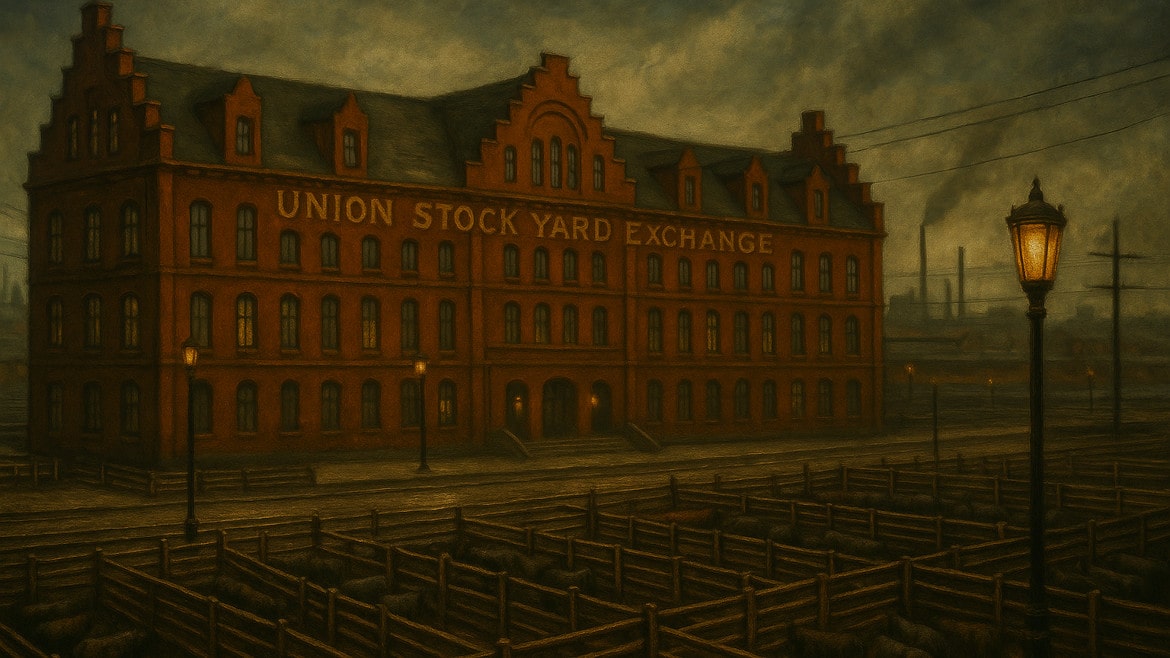“They called it the Exchange, but not everything traded there had a price.”
Description - Exterior
The Union Stockyards Exchange Building looms like a courthouse built for cattle—four stories of sandstone and soot perched at the old entrance to Exchange Avenue. Its arched windows are soot-dark, and the main facade bears a weathered carving: CHICAGO UNION STOCK YARDS – EXCHANGE. Pigeons roost in the cornices, and every so often, a pane of glass rains down like the building’s trying to spit something out. The copper bell in the tower above hasn’t tolled since the war—but people still claim to hear it at dawn.Description - Interior
Inside, it’s quiet—too quiet. Echoes linger longer than they should in the vaulted lobby, where dust cloaks marble floors and the receptionist’s desk sits like a forgotten shrine. Most rooms are abandoned offices with ledgers turned to stone and filing cabinets that rattle when no one’s near. The second floor boardroom, once where cattle futures were decided, still holds a long oak table carved with names—some famous, some cursed. The air smells faintly of old ink, leather, and something metallic deeper down. The freight elevator works only at night.History
Built in 1893 at the height of the Yards’ power, the Exchange Building was once the administrative heart of America’s meat empire. Here, inspectors, bankers, and brokers traded more than animals—favors, bribes, policies, even souls if you believe the stories. It was shuttered after WWII when operations decentralized and rail traffic waned. The building technically remains under city ownership, but no one’s bothered to list it in any public plans. The Outfit has since made quiet use of the upper floors, and Veil-sensitive locals whisper about “ghost contracts” still binding certain hallways.Owned By
Officially city property. Unofficially? A legal gray zone used by Bagels’ Outfit crew for meetings and stash work.Run By
Ms. Ethel Brannick, former clerk, now unofficial caretaker. Dresses like it’s still 1935. Keeps the first-floor lights on and talks to the walls like they answer.Employees
- None on paper—but a man in a brown suit can be seen copying numbers in the old records room most evenings.
Regulars
- Outfit lieutenants running “dry meetings” in the boardroom
- Academic types poking around in the archives, often gone by morning
- A girl in a pageboy cap seen drawing cattle brands in chalk on the tile floor
- Union boys paying quiet visits to confirm old dues or collect older threats
Notes
Mr. Shaw
Beneath the cracked tile and ledger-stained floors of the Stockyards Exchange Building, something old still claws for profit. The old-timers don’t speak his name, but the ledgers call him Eldrick Shaw—a broker from the golden days of the yards, back when anything could be bought for the right price. Livestock, laborers... human stock, too. The kind used for Veil rituals, soul-binding contracts, and blood-fed charms. He made a fortune trafficking flesh laced with power, and when the world moved on, he didn’t. They say Shaw died ugly—ripped apart by one of the beings he tried to sell to a cult down in Stickney. But death didn’t take. Too steeped in the Veil. Too stained with the currency of souls. Now what’s left of him lingers in the basement, deep behind locked crawlspaces and iron-welded walls. He’s not a ghost. He’s not a man. Something in between—a rotting shell animated by decades of deals and blood-oaths, always muttering about rates, value, and the “condition of the merchandise.” Shaw hunts in silence. When he gets strong enough, people go missing—usually drifters, junkies, or the kind of folks no one reports. They say he still runs a private market down there, bartering bound spirits and Veil-tainted relics with things that knock three times and never show their faces. Some crews believe if you can reach him, you might buy something unholy and priceless—Veil-slick grimoires, pre-Partition relics, charms carved from captive souls. But the price? It's never coin. And gods help you if he decides you’re the product. Once he marks you as inventory, you don’t dream right. You start seeing price tags on people’s eyes. You wake up in places you didn’t fall asleep. And eventually, you don’t wake up at all—just get wheeled into the dark, while Shaw croaks out a sales pitch to something no one’s ever seen and lived.Hooks
- The building’s blueprints show a fifth floor that doesn’t exist—until you take the elevator at 3:33 a.m.
- One desk in the southern wing still has an inkwell that never runs dry—but the ink writes in reversed text
- The last three records pulled from the archive all vanished—along with the men who accessed them
- During eclipses, the Exchange bell tolls—regardless of weather, time, or function
- The freight ledger from 1927 lists a shipment “unmarked, unpaid, unreleased.” It’s stamped with a symbol no one recognizes



Comments